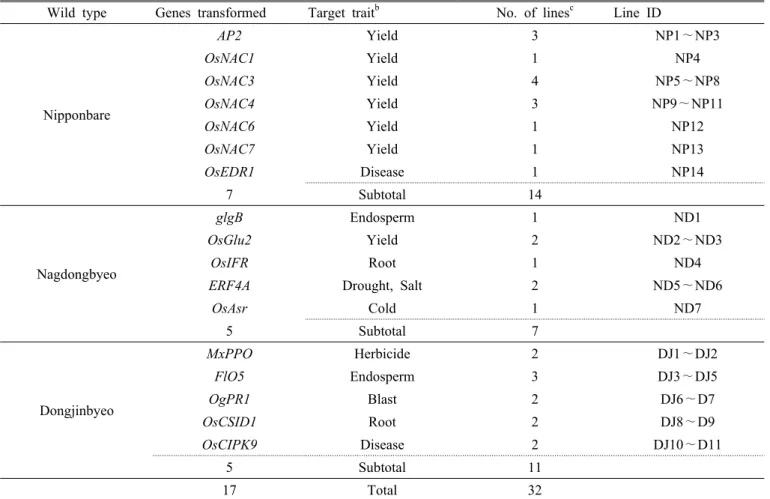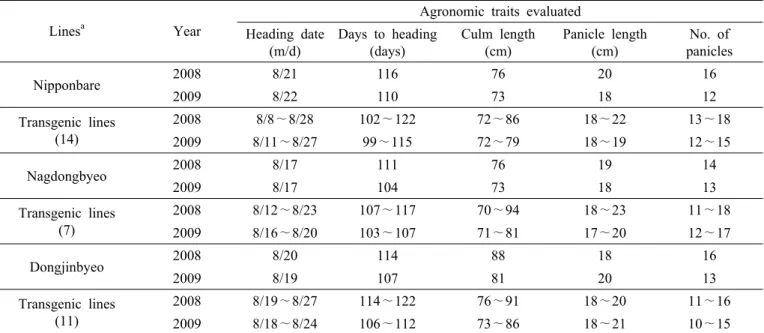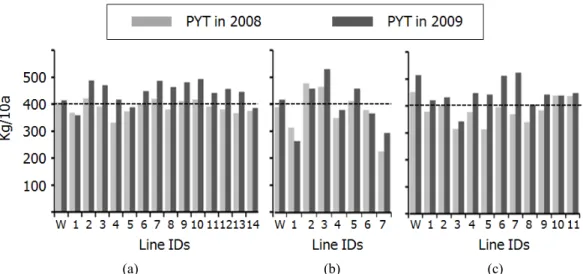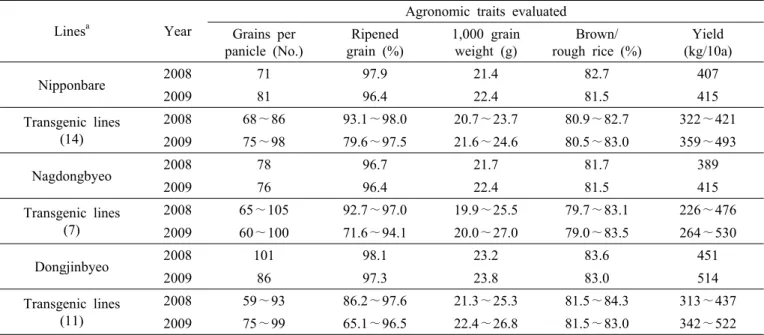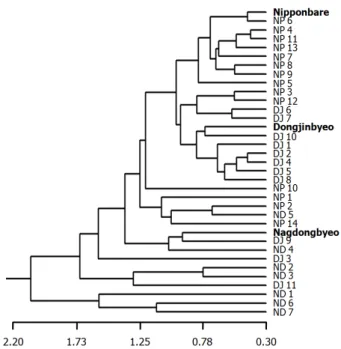벼 형질전환계통의 주요 작물학적 특성에 대한 고찰
정종민* ・ 정지웅**† ・ 강경호** ・ 이상복* ・ 박향미** ・ 김정곤** ・ 김경민*** ・ 손재근***
*국립식량과학원 춘천출장소, **국립식량과학원 답작과, ***경북대학교 응용생명과학부
Evaluations on agronomic traits of rice transgenic lines
Jong-Min Jeong*, Ji-Ung Jeung**†, Kyung-Ho Kang**, Sang-Bok Lee*, Hyang-Mi Park**, Chung-Kon Kim**, Kyung-Min Kim***, and Jae-Keun Sohn***
*Chuncheon Substation, NICS, RDA, Chuncheon 200-940, Korea
**Rice Research Division, NICS, RDA, Suwon 441-100, Korea
***College of Agriculture & Life Science, Kyungpook National University, Daegu 702-701, Korea
196
†
Corresponding author: (Phone) +82-31-290-6728 (E-mail) jrnj@korea.kr
<Received 22 April, 2013; Revised 13 May, 2013; Accepted 17 May, 2013>
ABSTRACT This study was conducted to evaluate the
performances of rice transgenic lines along with their wild types in terms of agronomic traits. A total of 32 rice transgenic lines, through previously conducted collaborative researches between molecular biologists and conventional rice breeders, were selected as promising lines. As the introduced functional genes, 17 genes, which were putatively related with high yield, disease and herbicide resistance, abiotic stress tolerance, and diversi- fying endosperm starch components, were transformed into three Japonica cultivars, Nipponbare, Nagdongbyeo, and Dongjin- byeo. The transgenic lines exhibited significantly deviated performances from their wild types on agronomic traits such as days to heading, culm length and yield potential. Multivariate analyses on transgenic lines to the evaluated agronomic traits also indicated random manner of phenotypic deviations from their wild type in terms of deviation directions and degrees. Our results suggested that, therefore, breeding strategies to control unexpected deleterious phenotypic performances among transgenic lines would be critical as much as the functions and proper expressions of the transformed genes.Keywords : Rice, Transgenic plant, Agronomic trait
서 언
생명공학 기술을 이용하여 무르지 않는 토마토(Flavr savr) 가 1994년 미국의 칼젠(Calgene)사에 의해 최초로 상업화 된 이후 제초제 저항성 콩(Round up ready), 내충성 저항성 옥
수수(Bt maize) 등의 품종이 상업화 되었으며 현재까지 옥수 수, 콩, 목화, 카놀라 등 22개 작물에서 제초제 저항성, 해충 저항성 등의 유전자를 도입한 GM작물이 상업화 되었다.농 업생명공학 국제서비스(International Service for the Acquisition of Agri_Biotech Application, ISAAA)의 보고 (James, 2011)에 따르면 현재까지 옥수수, 콩, 목화, 카놀라 등 22개 작물에서 201개의 GM품종이 개발되었고 세계적으 로 28개국, 1억 6000만ha의 농지에서 약 1,730만 농업인이 GM작물을 재배하고 있으며, 아시아 개발도상국 및 아프리 카 국가를 중심으로 그 면적은 앞으로 더욱 확대될 전망이다.
국내에서 아직까지 실용화된 GM 작물은 없으나 농촌진 흥청, 대학, 및 산업체 등을 중심으로 벼, 콩, 배추, 담배 등 의 작물에 대한 제초제 및 해충 저항성 GM작물의 개발이 활발하게 이루어지고 있어(한국 바이오 안정성 정보센터, 2012) 가까운 장래에 실용화 될 것으로 기대하고 있다(Kim el al., 2005, 2006). 벼에 있어서도 수량성 증대, 병해충성 저항성 증강, 불량환경에 대한 적응력 증가 및 신기능성 물 질생산 등에 형질전환 기술이 활용되고 있다. GM작물은 작물의 수량성 및 기능성 향상을 통하여 재배안정성을 높이 고 생산비를 줄일 수 있는 이점이 있으며, 육종적인 측면에 서는 전통적인 육종방법으로는 불가능한 다양한 생물종으 로부터 유용한 유전자 도입이 가능하여 종간 교잡장벽을 극 복할 수 있는 수단된다. 그리고 기능을 알고 있는 유전자를 사용함으로써 형질발현 여부판단이 용이하고 육성된 신기 능성 품종에 대한 지적소유권 관리가 용이하다. 하지만 이 러한 장점에도 불구하고 벼 형질전환체의 조직배양 과정에
Table 1. List of transgenic lines evaluated
a.
Wild type Genes transformed Target trait
bNo. of lines
cLine ID
Nipponbare
AP2 Yield 3 NP1∼NP3
OsNAC1 Yield 1 NP4
OsNAC3 Yield 4 NP5∼NP8
OsNAC4 Yield 3 NP9∼NP11
OsNAC6 Yield 1 NP12
OsNAC7 Yield 1 NP13
OsEDR1 Disease 1 NP14
7 Subtotal 14
Nagdongbyeo
glgB Endosperm 1 ND1
OsGlu2 Yield 2 ND2∼ND3
OsIFR Root 1 ND4
ERF4A Drought, Salt 2 ND5∼ND6
OsAsr Cold 1 ND7
5 Subtotal 7
Dongjinbyeo
MxPPO Herbicide 2 DJ1∼DJ2
FlO5 Endosperm 3 DJ3∼DJ5
OgPR1 Blast 2 DJ6∼D7
OsCSID1 Root 2 DJ8∼D9
OsCIPK9 Disease 2 DJ10∼D11
5 Subtotal 11
17 Total 32
a
Detail information such as full names of each gene and pedigrees of transgenic lines are not shown to considerate the researchers, who developed the transgenic lines, in term of intellectual properties.
b
Categories on the target traits were based on the supplied information from the authentic developers; increasing yield potential(Yield), increasing disease resistance(Disease and Blast), diversifying endosperm characteristics(Endosperm), relating vigorous root development(Root), increasing tolerance levels against abiotic stresses such as drought, salinity(Salt), and Cold, and herbicide resistance.
c
Transgenic lines were assumed that the introduced genes had been genetically fixed within their corresponding host(wild type)
서Tos17과 같은 전위인자에 의한 체세포변이 발생과
(Hirochia et al.,1996) 도입유전자의 염색체내 위치효과 (Maqbool & Christou, 1999) 등에 의해 원품종의 유용한 농업형질이 교란되는 것은 해결해야 할 문제이다.
본 연구는 니폰바레, 낙동벼, 동진벼를 유전적 배경으로 하는 17종의 유전자가 형질전환 된 32개 벼 계통들의 작물 학적 특성을 관찰하여 향후 실용성 높은 형질전환 벼 품종 개발의 기초자료로 활용하고자 수행되었다.
재료 및 방법
식물재료
국내 대학과 국립식량과학원 간의 협력 연구를 통해 18
종의 유전자가 벼 품종에 형질전환 된 76계통을 확보하였 다. 이들은 형질전환 고세대 계통들로써 각 계통 내에서는 도입유전자와 농업형질들의 분리가 관찰되지 않는 계통들 이었다. 본 시험에 공시된 형질전환 계통들은 작물학적 표 현형의 균일성과 외관특성이 양호하여 선발된 32개 계통들 이다. 선발된 형질전환계통들은 모품종(Wild type)으로 니 폰바레, 낙동벼, 동진벼를 유전적 배경으로 하고 있다. 형질 전환 계통들을 모품종별로 구분하면 니폰바레는 7개의 유 전자가 형질전환 된 14계통, 낙동벼는 5개의 유전자가 형질 전환 된 7계통, 동진벼는 5개의 유전자가 형질전환 된 11계 통이었다(Table 1). 벼 형질전환체 육성자들이 도입유전자 의 발현으로 기대하였던 유용 목표형질들로는 수량성과 내
Table 2. Performance ranges of transgenic lines on the evaluated agronomic traits during the preliminary yield trials in 2008 and 2009.
Lines
aYear
Agronomic traits evaluated Heading date
(m/d)
Days to heading (days)
Culm length (cm)
Panicle length (cm)
No. of panicles
Nipponbare 2008 8/21 116 76 20 16
2009 8/22 110 73 18 12
Transgenic lines (14)
2008 8/8∼8/28 102∼122 72∼86 18∼22 13∼18
2009 8/11∼8/27 99∼115 72∼79 18∼19 12∼15
Nagdongbyeo 2008 8/17 111 76 19 14
2009 8/17 104 73 18 13
Transgenic lines (7)
2008 8/12∼8/23 107∼117 70∼94 18∼23 11∼18
2009 8/16∼8/20 103∼107 71∼81 17∼20 12∼17
Dongjinbyeo 2008 8/20 114 88 18 16
2009 8/19 107 81 20 13
Transgenic lines (11)
2008 8/19∼8/27 114∼122 76∼91 18∼20 11∼16
2009 8/18∼8/24 106∼112 73∼86 18∼21 10∼15
a
Lines are subgrouped based on the wild type used for developing transgenic lines. Total number of transgenic lines are indicated within parenthesis (see also Table 1).
병성 증대, 배유변이, 내한발 · 내염성, 제초제 저항성 및 뿌 리생육 강화 등을 들 수 있다(Table 1). 벼 형질전환체 육성 자들의 권익을 보호하기 위해 형질전환 계통들의 도입유전 자들과 계보도 등에 대한 구체적인 정보는 생략하였다.
벼 형질전환 계통들의 재배 및 작물학적 특성 평가 본 연구에 공시된 시험재료들의 특성평가는 2008년과 2009년 2개년에 걸쳐 수원에 소재한 국립식량과학원 GMO 격리포장에서 생산력 예비시험(Preliminary yield trials;
PYT)을 통하여 수행되었다. 4월25일에 파종하였고 주당 3 본을 기준으로 30x15cm의 재식거리로 5월25에 본답에 이 앙하였다. 시험구는 2반복으로 임의 배치하였으며, 본답 시 비량은 N-P2O5-K2O=9-4.5-5.7 kg/10a 이다. 질소는 기비, 분얼비, 수비로 나누어 기준시비량의 50%, 20% 30%를 시 용하였다. 인산은 전량을 기비로, 칼리는 기준시비량의 70%를 기비로, 30%를 수비로 시비하였다. 이외 제초제, 살 충체 살포 및 중간낙수와 병해충 방재 및 기타 포장관리는 농촌진흥청 표준재배법을 따랐다 (농촌진흥청 2000).
각 계통의 출수기는 40% 정도가 출수한 시기를 기준으로 조사하였고, 파종일 부터 출수기까지 소요된 일수를 계산하 여 출수일수를 계산하였다. 출수조사를 제외한 시험재료들 의 주요 작물학적 특성평가는 황숙기 이후에 수행되었다.
각 계통의 간장, 수장, 수수 등 주요 작물학적 특성을 평가
하기 위하여 각 시험구별 10개 개체들이 조사되었다. 농업 형질조사 성적은 평균을 산출하여 대푯값으로 사용하였다.
수량성 평가는 완숙기에 각 반복구의 100주로부터 수확 된 시료의 무게를 수분함량 15%로 보정한 후, 10a 당 수량 (Kg)으로 환산하였다. 제현율, 천립중, 등숙비율 등의 각종 수량구성요인에 대한 조사는 일부 수확시료를 취하여 조사 하였으며, 반복구의 평균값을 각 계통의 대푯값으로 사용하 였다. 백미수량(Kg/10a)은 정조 수량에 조사한 제현율과 현 백률(0.92)를 곱하여 산출하였다.
조사형질 값을 이용한 형질전환 계통들에 대한 다변량분석 모품종 대비 각 형질전환 계통들에서 관찰된 주요 농업형 질들의 유사성을 가름하기 위해 통계프로그램인 NTSYSpc (ver. 2.11)을 이용하여 주좌표분석(Principal coordinate analysis)와 군집분석(Cluster analysis)를 수행하였다. 이를 위해 농업형질별로 표준화(Normalization) 된 각 계통들의 평균값을 이용하여 모품종들과 형질전환계통들에 대한 유 사매트릭스(Similarity matrix)를 산출하였다. 유사매트릭스 산출에 이용된 계수(Coefficient)는 ‘Average Taxonomic Distance’이다.
주좌표분석은 유사매트릭스를 이용하는 주성분분석 (Principal component analysis)에 의해 추출된 1, 2차 주성 분에 대한 각 조작분류단위(Operational taxonomic unit;
(a) (b) (c)
Fig. 1. Graphical illustrations on the performances of transgenic lines in terms of major agronomic traits during preliminary yield trials in 2008 and 2009. Performance levels of wild type cultivars, Nipponbare (A), Nagdongbyeo (B), and Dongjinbyeo (C), are indicated with dashed line for each trait evaluated. Corresponding transformed genes for each transgenic lines (line ID) are indicated in Table 1. Days to heading (HD), Culm length (CL), Panicle length (PL), and Tiller number (TN).
(a) (b) (c)
Fig. 2. Yield performances of transgenic lines during preliminary yield trials in 2008 and 2009, along with their wild type (W) cultivars, Nipponbare (A), Nagdongbyeo (B), and Dongjinbyeo (C). Corresponding transformed genes for each transgenic
OTU)의 주성분점수를 이용한 산점도를 작성하여 모품종들에 대한 형질전환 계통들의 공간적 배치를 추론하였다. 군 집분석은 유사매트릭스로부터 역산된 비유사매트릭스 (Dissimilarity matrix)를 활용하는 UPGMA(Unweighted Pair Group Method with Arithmetic Mean) 기법을 이용하여 수 형도(Dendrogram)을 작성함으로 모품종들과 형질전환 계 통들 간의 군집형성 양상을 관찰하였다.
결과 및 고찰
벼 형질전환계통들의 주요 작물학적 특성
니폰바레, 낙동벼 및 동진벼를 모품종으로 17종의 유전자
가 형질전환 된 32계통에 대하여 2008년과 2009년 GMO 격리 포장에 재배하면서 주요 농업형질을 평가하였다 (Table 2, Fig. 1).
대부분의 형질전환 계통들의 출수기는 중만생종으로 모 품종과 비슷하거나 약간 늦어지는 경향이었다(Fig. 1). 반면 니폰바레 형질전환 계통들 중에서 모품종보다 11일∼13일 정도 출수기가 빠른 계통들이 확인되었다(Fig. 1A; ID=
NP1, NP2). 전체 형질전환 계통들에서 관찰된 간장은 70∼
94 cm 이었으며 형질전환 된 모품종에 따라 다양하였다 (Table 2). 니폰바레 형질 전환계통들의 간장은 모품종과 비 슷하거나 약간 길어지는 경향이었다(Fig. 2A). 낙동벼 형질 전환계통들은 모품종과 비교해 간장이 다소 작았다(Fig. 2B).
Table 3. Performance ranges of transgenic lines on the evaluated traits related with yield potential during the preliminary yield trials in 2008 and 2009.
Lines
aYear
Agronomic traits evaluated Grains per
panicle (No.)
Ripened grain (%)
1,000 grain weight (g)
Brown/
rough rice (%)
Yield (kg/10a)
Nipponbare 2008 71 97.9 21.4 82.7 407
2009 81 96.4 22.4 81.5 415
Transgenic lines (14)
2008 68∼86 93.1∼98.0 20.7∼23.7 80.9∼82.7 322∼421
2009 75∼98 79.6∼97.5 21.6∼24.6 80.5∼83.0 359∼493
Nagdongbyeo 2008 78 96.7 21.7 81.7 389
2009 76 96.4 22.4 81.5 415
Transgenic lines (7)
2008 65∼105 92.7∼97.0 19.9∼25.5 79.7∼83.1 226∼476
2009 60∼100 71.6∼94.1 20.0∼27.0 79.0∼83.5 264∼530
Dongjinbyeo 2008 101 98.1 23.2 83.6 451
2009 86 97.3 23.8 83.0 514
Transgenic lines (11)
2008 59∼93 86.2∼97.6 21.3∼25.3 81.5∼84.3 313∼437
2009 75∼99 65.1∼96.5 22.4∼26.8 81.5∼83.0 342∼522
a
Lines are subgrouped based on the wild type used for developing transgenic lines. Total number of transgenic lines are indicated within parenthesis (see also Table 1).
동진벼 형질전환 계통들은 니폰바레나 낙동벼 형질 전환계 통보다 간장이 다소 길며 모품종 보다도 긴 것으로 조사되 었다(Fig. 2C). 수장과 수수도 형질전환 계통들 내에서 크거 나 작아지는 등 큰 차이를 보였는데, 동진벼 형질전환 계통 의 경우는 대체적으로 수수와 수장이 감소하는 경향이었다 (Table 2, Fig. 1).
벼 형질전환계통들의 수량성
총 32개 벼 형질전환계통들에 대한 수량성 및 수량구성 요인에 대한 평가를 2개년에 걸쳐 식량과학원 수원에 소재 한 GMO 격리포장에서 수행되었다(Table 3, Fig. 2).
니폰바레 형질전환 계통들의 쌀 수량 분포는 322∼493㎏
/10a 로서 모품종의 수량과 비슷하거나 다소 적어지는 경향 이었다(Fig. 2A). 낙동벼의 경우 형질전환 계통간의 수량성 차이가 컸다(Fig. 2B). 이들 형질전환 계통 간 수당립수와 현미 천립중의 차이가 큰 것을 고려할 때(Table 3), 이 두 요소가 수량성에 큰 영향을 미치는 것으로 판단되었다. 동 진벼 형질전환 계통들의 수량성은 대체적으로 모품종보다 낮은 편이었으며 연차간 변이가 다소 큰 경향을 보였다 (Fig. 2C).
본 연구에서 검토된 형질전환 계통들 중 15개 계통들은 7종의 도입유전자들에 의해 수량성 증대가 기대되는 것들 이었다(Table 1; 니폰바레 6종 13개 계통, 낙동벼 1종 2개
계통). 니폰바레 형질전환 계통들은 2008년에 비해 2009년 에 모품종 대비 수량성이 증가하는 경향을 나타내었는데 (Fig. 2A), 이는 특히 간장과 주당수수의 증가에 따른 것으 로(Fig. 1A), 낙동벼 형질전환 계통 중 OsGlu2 유전자가 형 질전환 된 ‘ND2’, ‘ND3’ 계통들은 모품종 대비 쌀 수량이 매우 유의하게 증가였다. 특히 ‘ND3’의 2개년 쌀 수량평균 은 499 kg/10a로 공시된 32개 계통 중 가장 높은 수량성을 보였다(Fig. 2B). 이 두 형질전환 계통들은 모품종 대비 간 장과 수장이 유의하게 신장된 것들로써(Fig. 1B), 수량성 증 대가 오히려 포장도복을 야기할 수도 있을 것으로 판단되었다.
벼 형질전환 계통들에 대한 다변량분석
육성된 벼 형질전환체의 우수성이 부각되기 위해서는 도 입된 유전자가 적절히 발현되어야 할 뿐만 아니라, 모품종 의 작물학적 특성(혹은 우수성)이 잘 유지되어야 한다. 이를 가름하기 위한 수단으로 작물학적 특성과 수량성 및 수량구 성요인 등 총 9개 농업형질(Table 2, Table 3)을 이용, 3개 모품종 및 32개 형질전환 계통들에 대한 다변량 분석을 수 행하였다.
분석결과, 주좌표분석(Fig. 3)과 군집분석에 의해 작성된 수형도(Fig. 4) 모두에서 형질전환에 이용된 모품종과 도입 유전자들에 대한 각 형질전환 계통군들의 뚜렷한 집구현상 은 관찰되지 않았다. 즉, 대부분의 형질전환 계통들은 모품
Fig. 3. Association patterns among transgenic lines, comparing to their wild types, revealed by principal component analysis by using the agronomic traits evaluated during the preliminary yield trials in 2009. Explained amount of variance (%) by first and second principal components are indicated.
Fig. 4. Cluster analysis on transgenic lines by using evaluated agronomic traits during the preliminary yield trials in 2009. The ‘UPGMA’ method was applied to construct the dendrogram. Corresponding transformed genes for
종으로부터 상당히 편기된 분포를 나타내었다. 이러한 결과 는 벼 형질전환 계통들이 도입된 유전자의 발현양상 혹은 각 ‘event’들이 지니는 염색체 내 삽입위치에 등에 따라 모 품종에 비해 매우 이질적인 작물학적 특성을 나타낼 수 있 음을 강하게 시사 하였다.벼 형질전환과 우량계통 육성
본 연구에서 공시되었던 32개 벼 형질전환 계통들에 대 해 주요 농업형질을 평가한 결과, 대부분의 형질전환 계통 들이 모품종과는 상당히 다른 작물학적 특성을 발현하고 있 음을 알 수 있었다. 모품종에 대한 각 형질전환 계통군 내에 서 관찰된 작물학적 상이성은 일정한 방향성이 없는 무작위 적 양상이었을 뿐만 아니라, 그 변화폭도 3개의 모품종들의 작물학적 차이보다 훨씬 크게 관찰되었다(Table 2, Table 3, Fig. 3, Fig. 4).
모품종에 비하여 벼 형질전환 계통들의 작물학적 ‘표현형 왜곡’현상은 이미 많이 보고되고 있으며, 도입된 유전자의 염색체상 삽입위치, 도입된 유전자의 발현양상 및 모품종 유전자와의 상호작용 등의 기작으로 설명되어진다. Bashir
et al.(2004)은 형질전환 된 향미벼의 출수기가 모품종 보다
10∼22일까지 늦어지는 경향이 있다고 보고하였다. Park etal.(2007)은 제초제 저항성 유전자가 형질전환 된 벼 계통들
의 포장재배 시험에서 낙동벼 형질전환 계통들의 출수기는 모품종과 비슷하였으나, 일품벼 형질전환 계통들은 출수기 가 3∼6일 정도 빨라졌음을 관찰하였다. Lee et al.(2010)은 비타민A 성분을 강화하기 위한 육성된 ‘황금벼’의 출수기 가 모품종인 낙동벼 보다 3∼4일 빨라졌다고 보고한 바 있다.형질전환체 육성에 필수적 절차인 조직배양 과정 중 발생 하는 체세포변이(Somaclonal Variation)도 모품종이 지니는 작물학적 특성을 교란하는 원인으로 주목되어 왔다(Evans
et al, 1989). 다수의 선행연구 결과들은(Sohn et al., 1995;
Lim et al., 1998; Yamagish et al., 1997) 수수, 임성, 초형 등 모품종의 주요 작물학적 형질이 교란된 이유로 체세포 변이를 지목하였다. 그러므로 농업형질이 우수한 형질전환 품종의 개발을 위해서는 체세포 변이를 최대한 억제할 수 있는 조직배양 기술도 확립하여 적용할 필요가 있다. Toki
et al.(2006)은 벼 형질전환체의 조직배양기간을 단축하였
을 때Tos17의 copy수가 모품종과 차이가 없음을 보고한
바 있다. 또한 정 등(2012)은 우량 벼 형질전환 계통육성의 효율을 제고하기 위한 방편으로, 약에서 유래한 캘러스에 형질전환을 실시하고 모품종으로의 여교잡을 통해 형질전 환 계통에 내포된 불량 체세포변이인자를 제거하는 기법을 제안하였다.결론적으로 우량 벼 형질전환 계통 육성의 효율성을 제고 하기 위해서는 모품종에 형질전환 되어 발현될 유전자의 우 수성뿐만 아니라, 계통육성과정에서 다양한 유전학적 요인 에 의해 야기되는 ‘표현형 왜곡현상’을 적절히 제어 할 수 있는 육종전략도 함께 고려되어 야 할 것으로 판단된다.
적 요
국내 대학과 국립식량과학원 간의 협력 연구를 통해 확보 된 32개 벼 형질전환 계통들에 대하여 주요 작물학적 특성 및 수량성을 평가하였다. 이들 계통들은 수량성, 내병성, 스 트레스저항성, 미질변이 등에 관여하는 17종의 유전자가 니 폰바레, 낙동벼, 동진벼 등에 형질전환 되어 육성된 계통들 이다. 주요 결과는 아래와 같다.
1. 형질전환 계통들은 출수기, 간장, 수장, 수수 등의 주요 작물학적 특성뿐만 아니라 수량성에서도 모품종과 상당 한 차이를 보였다.
2. 조사된 벼 형질 전환계통들에서 조사된 농업형질에 대한 다변량분석 결과, 모품종에 비해 각 형질전환 계통군 내 에서 관찰된 작물학적 상이성은 일정한 방향성이 없는 무작위적이었으며, 그 변화폭도 3개의 모품종들의 작물 학적 차이보다 훨씬 크게 관찰되었다.
3. 따라서 우량 벼 형질전환 계통 육성의 효율성을 제고하 기 위해서는 모품종에 형질전환 되어 발현될 유전자의 우수성뿐만 아니라, 계통육성과정에서 다양한 유전학적 요인에 의해 야기되는 ‘표현형 왜곡현상’을 적절히 제어 할 수 있는 육종전략도 함께 고려되어야 할 것으로 사료 되었다.
사 사
본 연구는 작물유전체기능연구사업과 농촌진흥청 바이오 그린21사업(과제번호 PJ0081602011)의 지원으로 수행되었음.
인용문헌
